A tree in bloom is a beautiful addition to the garden. However, it appears really stunning when the flowers are grouped into enormous inflorescences. Tree hydrangeas have grown to be highly popular in recent years because not many trees can produce this look.
Do hydrangea trees actually exist, though? Why do seed and nursery vendors frequently add “tree” to numerous types of hydrangeas when they tend to be shaped like bushes? In reality, none of the hydrangeas are trees; instead, they all develop into bushes. Some, nevertheless, can still take the shape of a tiny tree if pruned correctly.
In this guide, we’ll take a look at the growth characteristics of hydrangeas and how one specific variety can be grown to have the appearance of a tree, rather than a bush.
Comparing Hydrangea Tree vs. Hydrangea Bush
| Hydrangea Tree | Hydrangea Bush | |
|---|---|---|
| Classification | Hydrangea paniculata | Genus Hydrangea |
| Alternative Names | Peegee Hydrangea, Limelight Hydrangea, Hardy Hydrangea | Hortensia |
| Origin | China, Japan | Asia, South and North America |
| Description | A hydrangea shrub that can be cultivated and pruned to resemble a tree. | A genus of shrubs that are deciduous and boasts flowers in a wide range of colors, from white to pink to purple. |
| Uses | Roots can be used for traditional medicine, while the plants themselves are used ornamentally. | Primarily used ornamentally. |
| Growth Tips | Can benefit from either full sun or afternoon shade. Also grows well with a layer of mulch to keep moisture in and reduce the temperature of the soil. | Choose varieties that are resistant to pests, as hydrangeas are susceptible to pests and disease. |
| Interesting Features | Can be used to treat urinary tract infections and other diseases. Can also be pruned to have a tree-like appearance. | Hydrangeas are very poisonous, so they should be kept from pets and kiddos. Their blooms can come in a wide variety of colors, depending on the variety. |
The Key Differences Between Hydrangea Tree and Hydrangea Bush
All hydrangeas are part of the same genus, Hydrangea. Contrary to popular belief, there is no such thing as a hydrangea “tree” in the traditional sense. Hydrangeas could technically be considered trees, but due to their small size, they are classified as a bush or shrub. Tree-like growth is not a characteristic of hydrangea trees. All hydrangeas will develop into shrubs with many stems if left to their own devices.
Hydrangea paniculata is the only variety of hydrangea that can grow into a tree, but only if there is some human intervention. When they are extremely young, nurseries prune them into single-trunk trees. Every year in the middle of the summer paniculatas bloom on fresh growth, and the display is stunning, whether or not they are pruned to look more tree-like. However, there are numerous types of hydrangeas in addition to paniculatas, which are all every bit as lovely as any other hydrangea.
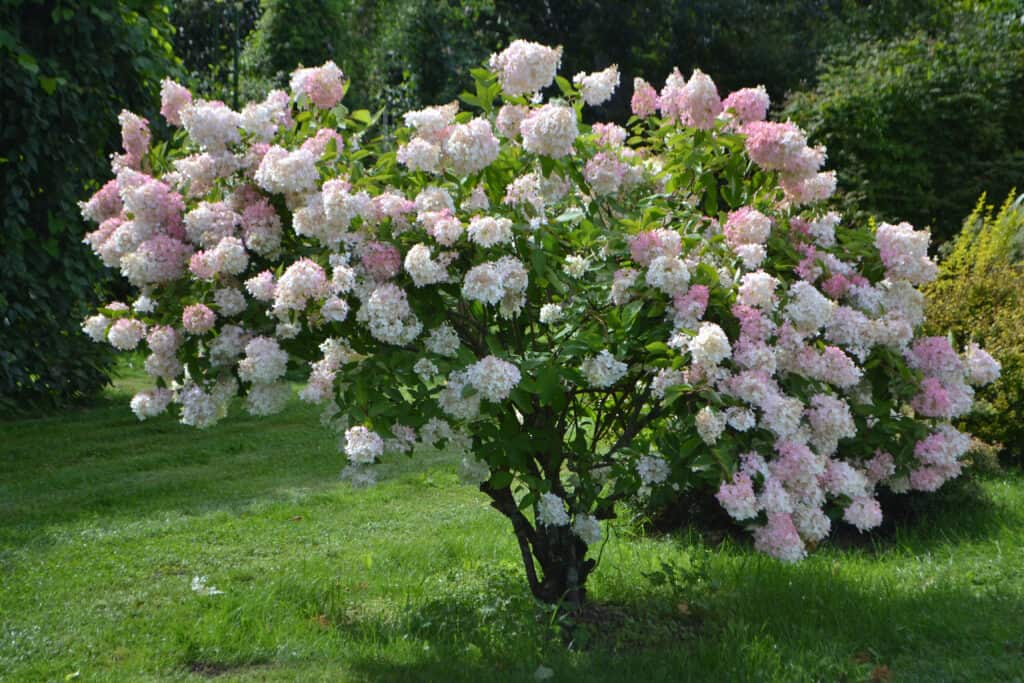
is the only variety of hydrangea that can be pruned to grow into a tree.
©Edita Medeina/Shutterstock.com
Hydrangea Tree vs. Hydrangea Bush: Classification
Hydrangeas, also known as hortensias, are a genus of 75 different flowering plants known collectively as hydrangeas. A vast majority are classified as shrubs. The Hydrangea paniculata, one such species of hydrangea, is the only variety that can be pruned to resemble a tree.
Hydrangea Tree vs. Hydrangea Bush: Description
Hydrangeas are shrubs that are deciduous and have terminal clusters of round, umbrella-shaped, white, pink, blue, or even purple flowers. Your soil is acidic if they bloom blue, and alkaline if they bloom pink. You’ll likely have purple flowers if your soil is anywhere between acidic and alkaline. Hydrangea leaves are opposite, straightforward, stalked, pinnately venated, up to eight inches long, toothed, and occasionally lobed.
The two flower configurations of hydrangeas are corymbs and panicles, which are typically seen at the stem ends. The flowerheads typically have two different flower types: little, uninteresting blooms in the center or interior, and huge, showy flowers with prominent, vibrant sepals. While commercial hydrangeas have been bred and selected to have larger blossoms, plants in wild populations often have few to no conspicuous flowers.
The eight to fifteen-foot-tall Hydrangea paniculata has upright, sharply pointed, conical, terminal flower panicles that contain both fertile and sterile flowers and blooms from mid-summer into the fall. Like all hydrangeas, this species can come in almost any color you can imagine, all of which depend on soil acidity.

Hydrangeas are shrubs with clusters of round, umbrella-shaped, white, pink, blue, or even purple flowers.
©iStock.com/Maryna Andriichenko
Hydrangea Tree vs. Hydrangea Bush: Uses
For their magnificent blossoms and exquisitely rounded flower heads, hydrangeas are renowned across the world. Since they are ornamental bushes, Hydrangea paniculata and other hydrangea species are mainly employed in landscaping. The majority of hydrangeas are deciduous shrubs that can reach heights of three to eight feet. They are therefore perfect for use as garden centerpieces.
Hydrangeas have stunning, spherical flower heads that are perfect for bouquets. The majority of cultivars bloom between early spring and late fall, which makes them perfect for a summer vase presentation. Some cultivars also give off delicately delightful smells, providing still another dimension to your cut flower arrangement.
Due to the fact that Hydrangea paniculata is the only kind of hydrangea that can be pruned to resemble a typical tree, it is virtually exclusively utilized for landscaping and ornamental purposes.
Medicine is made from the hydrangea’s underground rhizome and root. Although there is no solid scientific evidence to back these claims, people use hydrangeas to treat kidney stones, enlarged prostates, bladder infections, and other diseases. Using hydrangea in big quantities may potentially be harmful.
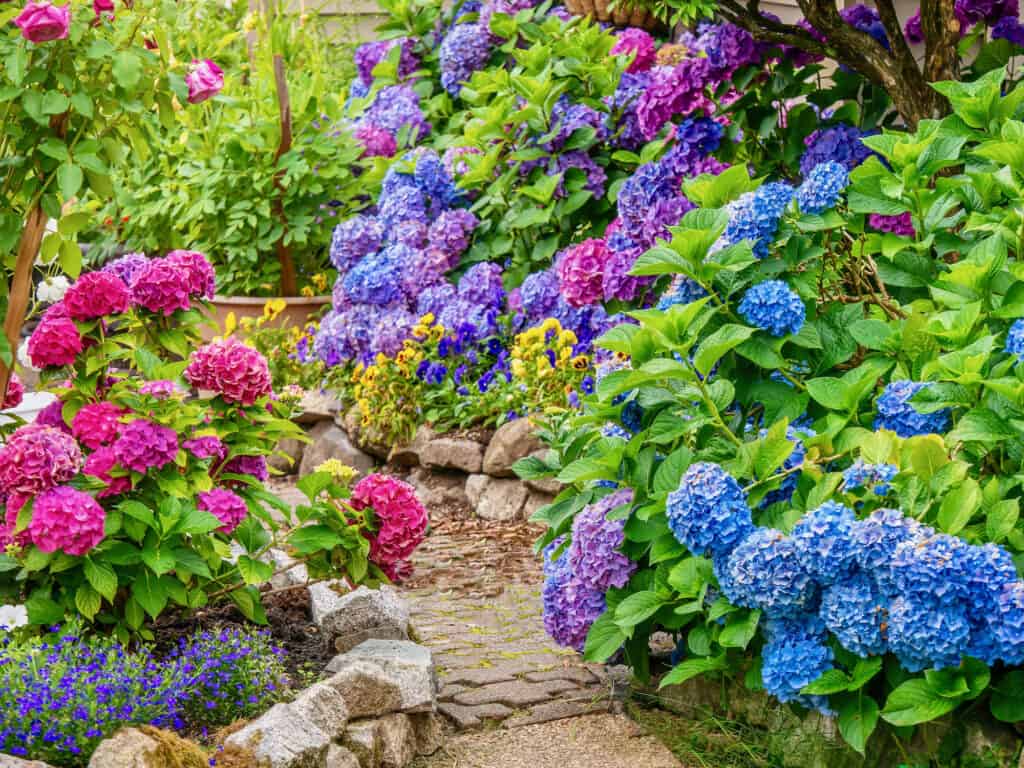
Hydrangeas are deciduous shrubs that can reach heights of three to eight feet making them perfect for use in ornamental gardens
©iStock.com/Cheryl Ramalho
Hydrangea Tree vs. Hydrangea Bush: Origin
Japan is where Hydrangea was initially grown. These flowers are indigenous to Southern and Eastern Asia, as well as to North and South America, Japan, Korea, China, the Himalayas, and Indonesia. Although the hydrangea plant was first domesticated in Japan, prehistoric fossils of the plant from 40 to 65 million years ago have been found in North America. It is believed that a colonist who brought a North American variety to England in 1736 was the first to introduce hydrangeas to Europe. Hydrangea paniculata is native to China and Japan.
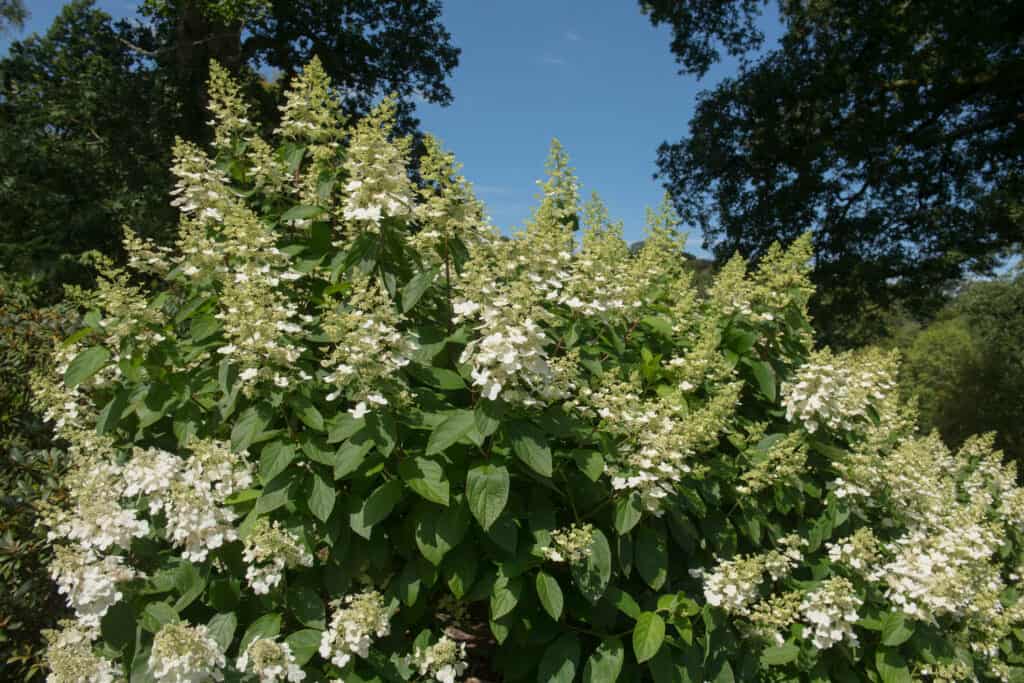
Hydrangea paniculata has upright, sharply pointed, conical, terminal flower panicles.
©iStock.com/pcturner71
Hydrangea Tree vs. Hydrangea Bush: How to Grow
All hydrangeas, including Hydrangea paniculata, can be grown mostly the same way with the same general guidelines.
The optimum seasons to plant hydrangeas are in the fall and early spring. The objective is to give the shrub plenty of time to establish a solid root system prior to blooming. The best place to plant hydrangeas is in a protected area that receives both morning and afternoon shade. For hydrangeas to flourish, the soil must be rich in organic matter. Drainage is crucial. Although they prefer moist soil, hydrangeas cannot tolerate standing water. For planting hydrangeas, just make planting holes that are two feet broader than the root ball. Match the depth of the hole to the size of the root ball so that your plant is level with or slightly above the surrounding soil.
The Hydrangea paniculata is the only variety of hydrangea that can take the shape of a tiny tree. It does not grow new branches from the root and is ideally suited to forming the required shape of an ornamental tree. It is not possible to cultivate other hydrangea species as trees. Even after severe pruning, they will continue to grow new branches at ground level and resume their bush-like appearance.
There are a few procedures you should follow if you want your Hydrangea paniculata to develop to resemble a tree. These bushy plants are hardy in agricultural Zones 3 – 9 and have enormous, conical flowers. They produce buds in the spring, flower on new wood, and grow quickly and hardy.
Having clean equipment on hand is crucial throughout the entire clipping process, so keep that in mind as you prepare to do some serious clipping. Your plants will be vulnerable after pruning, especially after the initial trim, so you don’t want to introduce pests or disease pathogens to them. Before beginning and in between plants, clean your shears or clippers by immersing them in a 10% bleach solution.
You have the option of starting with a more mature plant or a rooted cutting like the nurserymen do. In either case, be patient! Be ready to create a close bond with your pruning shears during this procedure because it can take more than five years to mold a perfectly manicured tree from a hydrangea.
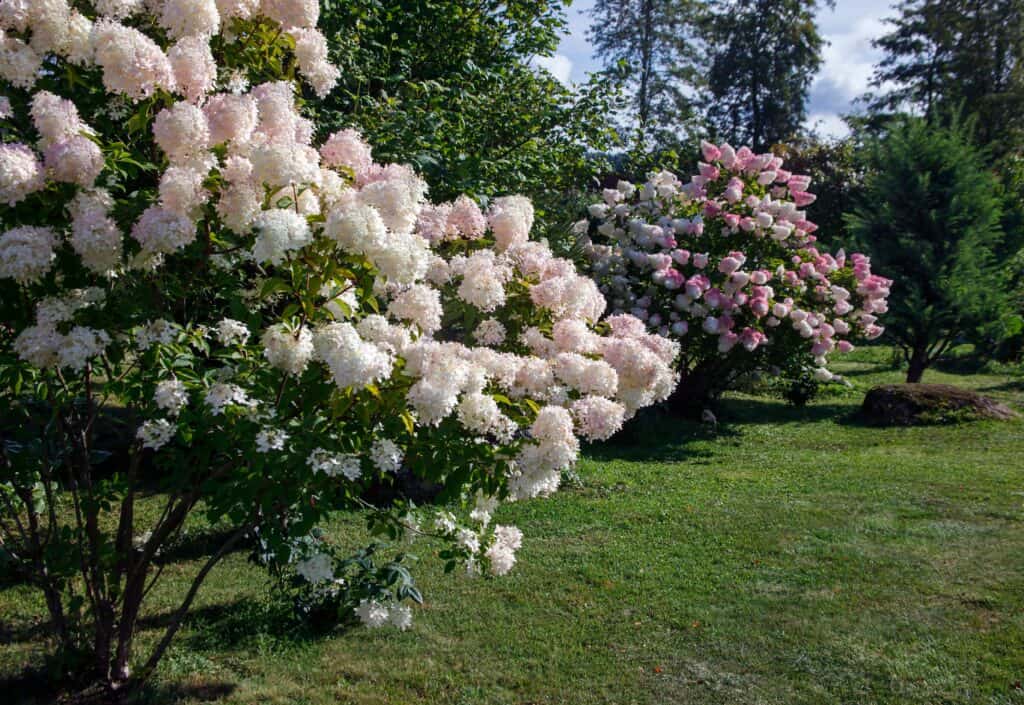
It can take more than five years to mold a perfectly manicured tree from
Hydrangea paniculata.
©Okyela/Shutterstock.com
Hydrangea Tree vs. Hydrangea Bush: Special Features
Hydrangeas, including Hydrangea paniculata, don’t actually have petals. The color blooms you see are actually sepals, which are a type of leaf that protects the internal flower. Hydrangeas can actually drink water through their sepals rather than just from their roots.
Whether you opt for Hydrangea paniculata so that you can prune it into a tree or any other hydrangea variety, you’ll get a pretty stunning flowering plant that will be a real eye-catcher in your garden. If you follow planting and watering instructions properly, you shouldn’t have any trouble growing any variety of hydrangea that you’d like!
Bonus: Hydrangeas Not Blooming? We Have the Answers
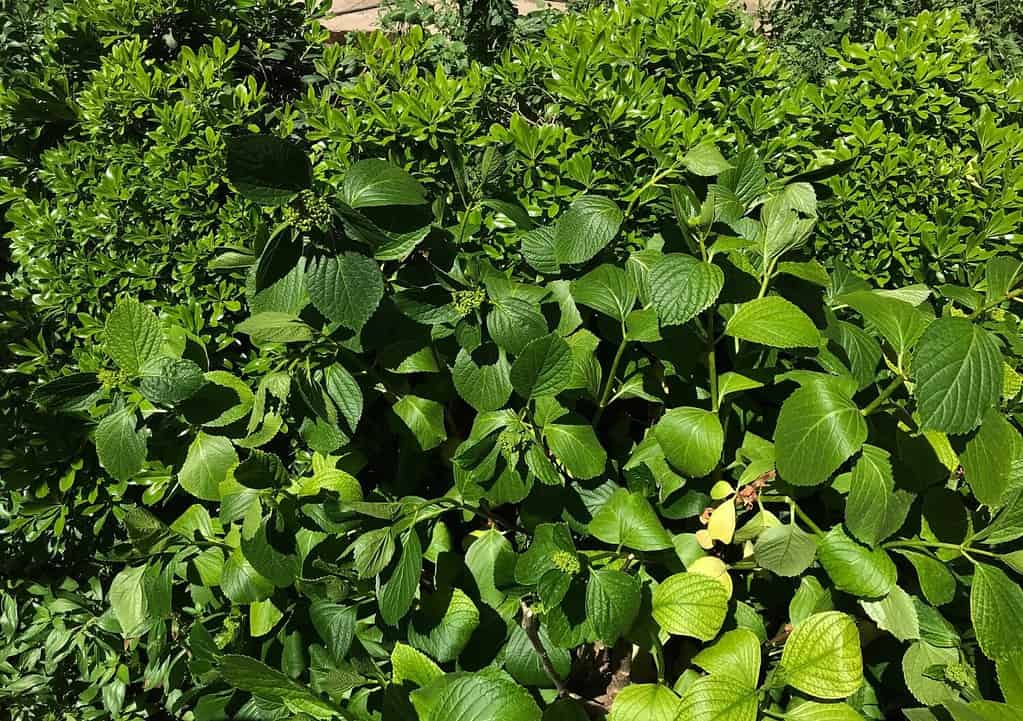
It is disheartening to realize that your hydrangea isn’t going to bloom.
©Hatice Sever/Shutterstock.com
If you look forward to seeing your hydrangeas bloom every year – it is a great disappointment when those big showy blooms never come. The leaves are lush and green but either buds never form or don’t develop – what has gone wrong? There are many things that can keep your hydrangeas from blooming – here are some reasons and solutions:
- Too Much Shade. Depending on the variety – most hydrangeas can tolerate a little shade – but most need several hours of direct morning sun. Consider moving your plant to a better location.
- Too Much Sun. Apparently, a sweet spot must be found for these plants. Too much direct sun may stress the plants causing them to conserve energy by not flowering.
- Improper Pruning. It is crucial for you to learn whether your hydrangea variety blooms from old wood or new – and prune accordingly. Bigleaf, oakleaf, climbing, and mountain varieties all bloom on old wood. Unless they get too big – it’s best not to prune them at all. The blooms will dry out and be replaced with new flowers next season. Panacle and smooth varieties bloom on the current season’s growth. (Limelight and White Wedding) Prune these in late winter or early spring.
- Cold Weather. A harsh winter or hard freeze can damage developing flower buds, which may result in a summer with no flowers. Mulch the area around the base of the plants in fall with several inches of leaves or straw to insulate roots. Protect plants with a covering during cold spells or frosts.
- Not enough water. Hydrangeas need a lot of water to do well. Too little water can result in stunted growth or no blossoms the next season. If plants are drooping or wilting they need to be watered immediately.
- They are too young to bloom. It can take newly planted hydrangeas up to 5 years before they begin blooming. You can buy larger plants if you want flowers sooner.
The photo featured at the top of this post is © SariMe/Shutterstock.com
Sources
- YouTube, Available here: https://www.youtube.com/watch?v=jGDjr2OrS_0
- Wikipedia, Available here: https://en.wikipedia.org/wiki/Hydrangea
- NC State Extension, Available here: https://plants.ces.ncsu.edu/plants/hydrangea/
FAQs (Frequently Asked Questions)
Is there a difference between hydrangea trees and bushes?
All hydrangea varieties are bushes. However, they can be grown in a particular way to resemble a tree.
Which hydrangea variety can be grown in the shape of a tree?
Hydrangea paniculata can be grown into a tree-like shape by pruning its leaves while the plant is young.
Do hydrangeas get fairly large?
Yes. Hydrangea paniculata grandiflora can grow as high as 30 feet, though they average around 25 feet in height.
Thank you for reading! Have some feedback for us? Contact the AZ Animals editorial team.






